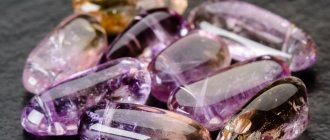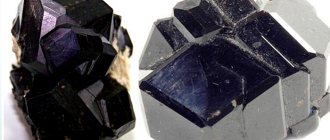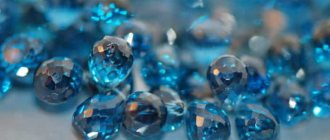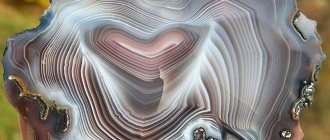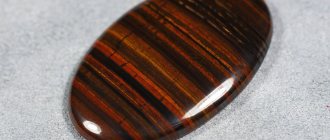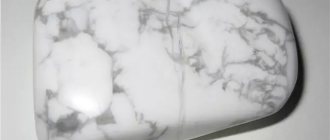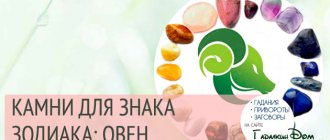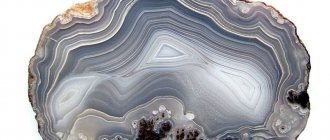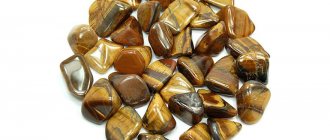- Almandine (garnet group).
- Color: red with a purple tint.
- Hardness: 7.5 points.
- Density: 3.95–4.20 g/cm³.
Almandine is a type of garnet, but it differs from the latter in its high hardness and color (almandines have purple, red-violet and black shades). However, burgundy stones, cherry-colored minerals, and even brown and orange almandines can also be found - it all depends on the iron impurities in the structure.
As a rule, almandine is a mineral with a diameter of 0.5–2 centimeters, but large specimens with a diameter of 40 mm or more are also found. If the stone is still transparent and has a uniform color, then such almandines are highly valued. For inlays, in most cases, stones measuring 0.5 cm are used.
Story
Almandine garnet was first mentioned before our era. There is a legend about it, and the great alchemist of the Middle Ages gave it its current name.
Legends
One of the legends says that these stones were the pupils of a chimera, that is, a half-snake, half-woman. She left them on the shore, and she herself went into the water and there lay in wait and destroyed those who wanted to take possession of the gems. It was believed that these pupils-pebbles were the key to countless treasures.
In Ancient Greece, the red-brown mineral was considered the stone of the harvest goddess Demeter. Red almandine was the stone of Hestia, the goddess of the hearth and sacrificial fire. Therefore, this gem is considered a mineral of two elements: Earth and Fire.
The biblical legend says that Noah illuminated his ark with this gem during the flood.
In Europe, almandines were considered the stones of balls and masquerades, since the red color improves mood.
Titles
In ancient times, this mineral was called Alabandian carbuncle . Translated from Latin, “carbunculus” means coal. And the most beautiful specimens looked like burning coals.
Another ancient name is Alaband ruby in honor of the city of Alaband (Asia Minor, now Turkey). It is believed that the gem was mined and cut there or only resold.
In the mid- 16th century, the warlock and alchemist Gregory Agricola made a description of this stone and, in addition, shortened the cumbersome names to “almandine”.
Other names for the mineral are also known:
- oriental pomegranate;
- anthrax;
- Siberian, Greenland or Ceylon ruby;
- carbuncle (as European jewelers called the stone).
Where is the stone mined?
The world's main supplier of almandines is Myanmar (formerly Burma).
The highest quality stones are mined here.
There are deposits of the mineral on all continents of the planet, including Antarctica.
Each pebble has its own shades, often named after the place of extraction:
- Sri Lanka (formerly the island of Ceylon) - a deep red stone imitating a ruby; known as the "Ruby of Ceylon";
- Finland – stones with asterism;
- Norway – a rare black variety of stone a meter long was found here;
- Sweden - red-brown specimens.
Russian almandine deposits are concentrated in Siberia (“Siberian rubies”) and on the Kola Peninsula.
Physicochemical characteristics
Almandine is a mineral from the garnet family.
- The chemical formula is Fe3Al2(SiO4)3 .
- Color - crimson, brownish-red, ripe cherry, purple, black (rare).
- The shine is glassy or resinous.
- Transparency - from zero to complete.
- Hardness -7–7,5.
- Density - 4.3 g / cm3 .
The shade depends on iron: the more iron there is in the mineral, the purer and thicker the red color (such specimens are the most valuable).
According to the color description, almandine is sometimes confused with another variety of garnet - pyrope. Online stores sometimes sell stones called “almandine-pyrope.”
In nature, almandine is found in the form of grains with weakly defined edges and in the form of intergrowths of crystals.
Jewelry shopping
Almandine is the most common representative of the large group of garnets, so you can find a variety of jewelry with this stone. On the website miuz.ru you will find rings, earrings, bracelets and pendants with almandine, as well as brooches, as well as jewelry crosses with this mineral. The main assortment consists of gold jewelry.
Keep an eye out for discounts in our online store to make your jewelry purchases even more profitable. We deliver orders to your home and to MUZ brand stores.
Application
Jewelry making and decorative arts are the main areas of application of this gem.
Jewelry
Almandine is a gemstone very similar to ruby, which is why it is prized by jewelers.
4–6 mm in size are used to make jewelry ; larger ones are rare.
When processing, the ancient shape of the saucer-shaped cut is used. Then the crystal becomes more transparent, and the internal play of color becomes more intense.
Previously, almandine was used to decorate the robes of clergy. This gem was also an attribute of the secular nobility.
Almandine is set in 925 sterling silver or 585 gold.
In jewelry, it is often combined with the following stones;
- kunzite;
- chalcedony;
- cubic zirconia (red and colorless).
Dark brownish specimens are sometimes complemented with dark amber.
Jewelry manufacturers do not always label the stone as almandine. Sometimes the tag simply says “garnet.”
Other areas
Low-transparent specimens are used as an element of decoration for church paraphernalia (monstrances, crosses, bowls) and secular paraphernalia (boxes, tabletop writing utensils, fireplaces). They also grind small plastic pieces out of them.
Countertops are made from opaque stones, the price of which is tens of thousands of rubles.
Properties
Almandine - Almandin.
Iron and aluminum silicate, aluminum garnet.
Physico-chemical
- Possible inclusions: zircon, apatite, rutile.
- There is no pleochroism.
- Fluorescence is zero.
- Insoluble in hydrochloric acid.
- Has pyroelectric properties.
- The color is sometimes so bright that the gem seems opaque.
Due to the thickness of the color, the stones are cut concavely on the bottom side, in the shape of a bowl, and foil is placed underneath to increase the shine of the stone. This form of cutting specifically for garnets was found already in ancient times and is still practiced today.
A gem can have a 4- or 6-rayed star - an asterism effect.
Lithotherapist's book
A Russian medical book of the 16th century informs that almandine is a stone: “it will cheer the heart, it will drive away inappropriate thoughts, it will increase the mind and honor.”
Indian “Ayurveda” reports that this stone is beneficial for disorders of “vata” and “kapha” - an imbalance in the energies of the Elements in the body. Now they say that this is a metabolic disorder.
Among popular connoisseurs, the gem is an excellent antidepressant.
Almandine, according to lithotherapists:
- Stimulates the owner's reproductive function.
- Disinhibits libido.
- Helps heal wounds.
- Stabilizes heart function.
- Used for inflammatory processes.
- Accelerates the regeneration of tissues and organs.
The magic of a lucky stone
Almandine is a holiday stone, a carnival stone. The brilliant and cheerful “coal” was considered a stone of fun. It relieves sadness and melancholy, from pain and sadness, and brings joy to life.
In Europe it was considered a symbol of constancy and fidelity, devotion and strength.
According to astrologer L. Nazarova, almandine provides its owner with a connection with the future.
A gem, as esotericists believe:
- Will facilitate advancement to responsible positions.
- Increases financial flows.
- Gives the owner respectability.
- It will help you survive difficulties and problems.
- The stone will help its owner to believe in their strength and capabilities.
In Europe they said about almandine: “drives away fears and sorrows, excites passion and moderates anger, brings joy, heals the heart and brain.”
Important : Do not wear almandine jewelry every day. A holiday is good sometimes, that’s why it’s a holiday. It’s not for nothing that they say “time for business, time for fun.”
Medicinal properties
Almandine amulets were worn by crusaders to protect themselves from illness and injury.
The healing properties of this stone began to be studied by the ancient Hindus.
When using the stone for medicinal purposes, you should not refuse treatment prescribed by your doctor.
It is believed that almandine stone can help in many cases:
- Its main property is that it promotes the disappearance of phantom pain and the healing of wounds (if they are not old).
- Useful for joint diseases.
- Improves blood circulation and vascular condition. May normalize blood clotting and hemoglobin levels.
- Contemplating a pebble for a few minutes a day is good for the eyes and helps overcome depression.
- Metabolism, gastrointestinal tract and kidney function are normalized.
- Immunity is strengthened.
- If you have breathing problems, a stone set in silver can help.
The healing properties of almandine are more pronounced if the stone comes into contact with the human body. It should be worn no more than two days a week (but not in a row), since due to the element of Fire, to which the stone belongs, it puts too much strain on the nervous system.
Lithotherapists do not recommend wearing almandine with other garnets, as well as with tourmaline.
Healing properties
Almandine is one of the most popular minerals in lithotherapy. First of all, because the price for it has never risen high. And secondly, popularity is dictated by a wide range of applications. Ayurvedic practitioners recommend turning to almandine if you need to strengthen your immune system or regulate your metabolism.
Russian lithotherapists use the mineral to normalize the functioning of the cardiovascular system. In addition, according to popular belief, prolonged contact with almandine has a positive effect on the condition of the reproductive system.
Magic properties
Almandine has meaning for a person who recognizes the influence of the energy of stones on owners.
The magical properties of this mineral have been used for a long time. They help people in many ways.
Overall Impact
The magic of almandine manifests itself in the following areas:
- Charm. Stones of rich red color create an aura of attractiveness around their owner.
- Emotions. An aggressive person becomes more balanced. Anxiety disappears, and the ability to look at life philosophically and foresee the consequences of one’s actions appears.
- Personal life. The pebble will help you find love. And if it has already been found, it will add devotion and fidelity to the relationship. People will be happy in love.
- Amulet from problems. The almandine stone tries to protect a person from all kinds of negativity. In this capacity, it goes well with malachite and onyx.
- Road amulet. Protects you while traveling or on a trip from unkind fellow travelers and thieves.
- Mascot. Brings peace of mind, well-being, inspiration, luck, love, and brings you closer to knowledge of the truth.
In the East, almandine is considered a talisman that relieves heartache and sadness and gives joy to life.
The magic of almandine does not depend on the frame material. It is strong in gems in both silver and gold.
Stone color
The magical properties of the mineral are influenced by the shade that complements the red color:
- Scarlet is the embodiment of victory;
- Raspberry - adds confidence in one’s rightness and strength;
- Brownish - gives harmony of soul, joyful attitude, energy; useful for older people.
- Orange - protects against external negativity.
- Purple - will help overcome obsessive fears.
If almandine is supplemented with onyx or malachite in a talisman, the magical properties of the stone are more pronounced. The person will be lucky and healthy.
Therapeutic effect
The ancient Hindus were the first to study and use the healing properties of almandine.
The specialization of the stone is wide:
- The main property is to heal wounds and relieve phantom pain. A pendant, brooch or necklace near the heart helps after a myocardial infarction. But the strength is maximum if little time has passed. Old wounds, especially scars, have problems healing.
- The stone treats arthritis, arthrosis, radiculitis, joint pain.
- Normalizes everything related to blood: hemoglobin level, blood circulation, coagulation, vascular health.
- Strengthens vision, nerves, relieves depression. To do this, it is enough to contemplate the pebble for a few minutes a day or wear earrings.
- Helps heal the gastrointestinal tract and kidneys.
- Almandine strengthens the immune system.
- A stone set in silver neutralizes breathing problems.
The healing properties of the mineral are most pronounced when it comes into contact with the human body.
Who is suitable according to their zodiac sign?
Almandine is contraindicated according to the horoscope for Gemini, Pisces, Cancer . Any green variety of pomegranate (for example, uvarovite) will suit them as a talisman.
The stone has ideal compatibility with three zodiac signs: Leo, Aries, Capricorn .
- Leo will become healthier and feel a surge of vitality. He will believe more in himself, in his intuition when choosing friends. Becomes more charming.
- Aries will be happy in his personal life, his career will go uphill. But you should not wear the stone often.
- Capricorn will become more charming, more sociable, and will look at the world more optimistically. All this will have a positive impact on success in the business sphere.
This mineral will also be useful for other zodiac signs:
- Virgo will feel inner harmony and good relationships with people around them. But you shouldn’t wear the stone all the time. You only need to turn to him for help if difficulties arise in life.
- Libra , in moments when they are lonely and sad, will feel the warmth and care of those around them.
- Scorpio will find in the gem an assistant in a relationship with a loved one. But there is no need to abuse the magic of the stone. If worn frequently, it may repel love.
- Sagittarius will feel a surge of strength, become more decisive and bolder.
- Aquarius will find an assistant in the stone in the implementation of their plans.
- Taurus will be able to overcome difficulties and reach new horizons. But some astrologers believe that representatives of this zodiac sign have poor compatibility with the energy of any type of pomegranate, since it is too dynamic for them.
Almandine and Zodiac
Almandine is not suitable for every zodiac sign:
- Contraindicated according to the horoscope of Cancer, Gemini, Pisces. Any green variety of pomegranate will suit them.
- Can be used by Taurus, Virgo, Libra, Scorpio, Sagittarius, Aquarius.
- Ideal as a talisman for Aries, Leo, Capricorn.
Table of compatibility of almandine with zodiac signs (“+++” – fits perfectly, “+” – can be worn, “-” – is strictly contraindicated).
| Zodiac sign | Compatibility |
| Aries | + |
| Taurus | + |
| Twins | — |
| Cancer | — |
| a lion | +++ |
| Virgo | + |
| Scales | + |
| Scorpion | + |
| Sagittarius | + |
| Capricorn | +++ |
| Aquarius | + |
| Fish | — |
Leos will become more attractive in the eyes of those around them. They will choose their friends wisely and become physically healthier. For Aries, the pebble will contribute to personal life and career growth. But you shouldn’t overuse it. Almandine will make stubborn Capricorns more charming, which will have a positive impact on the business sphere.
How to wear
The energy and magic of almandine determined the rules for its use:
- It is better not to wear almandine accessories to negotiations and business meetings: the stone can distract and interfere with concentration.
- This gem can be useful when traveling.
- If you wear jewelry with almandine all the time, you can become frivolous and disorganized. It is better to wear them from time to time for special and festive events.
- It is useful to wear an almandine stone for both men and women who have reached the age of 25 . Accessories with it help older people increase their vital energy.
Jewelry with almandine goes well with classic clothing styles. The best setting for this gem is gold; it emphasizes the beauty of the stone.
Chemical and physical properties of almandine stone
The bright appearance of the mineral is due to its physical and chemical properties. It contains iron, silicon, aluminum, which is why it is so hard.
Almandine stone formula: Fe3Al2[SiO4]3
What does almandine look like?
At least 20 species of this stone have been found in nature. They differ in color and shape. It can be deep red, crimson, cherry, purple, even black - depending on which metal predominates in the sample. The more iron, the redder the member of the family. The most common color is violet-red. Almandine color is a rich cherry or red wine color.
The size of the gem is from 2 mm to 4 cm.
There are both completely transparent and completely opaque specimens of glass or resinous luster. Jewelers are only interested in medium-transparent gems. Others are suitable in industry as raw materials for cutting and processing materials.
One of the characteristics of almandine is an uneven fracture, always with shells. Pebbles fade in the sun.
How to care
Although almandine has high hardness, it is vulnerable, so it requires careful care:
- It should be protected from sudden changes in temperature to prevent cracks from appearing.
- Do not wear jewelry when going to the pool or for a summer walk. Chlorinated water and direct sunlight will cause the stone to fade.
- The contaminated stone should be washed with warm soapy water, rinsed with clean warm water and immediately wiped dry with a soft cloth. If the pebble is very dirty, you can pre-soak it in a warm soap solution.
- Almandine can be cleaned with ultrasound.
- Do not use household chemicals, abrasives, or hot water when cleaning.
- You can store jewelry in a common box.
Compatibility with other stones
Before purchasing jewelry with almandine, you should study its compatibility with other stones. In this regard, the mineral is quite capricious. For almandine to become a magical artifact, it is better to combine it with malachite or onyx. An amulet consisting of these gems will give positive emotions, joy, good luck and protect from any negative influence.
Almandine absolutely does not combine with green garnets and other blue-green gemstones. It is highly undesirable to wear them nearby. These include:
- demantoid - green diamond-like garnet;
- uvarovite – emerald green garnet;
- grossular - gooseberry-colored garnet;
- sapphire is a type of corundum, a precious stone;
- aquamarine - belongs to the group of beryl minerals;
- emerald is a precious mineral, a type of beryl;
- Topaz is a semi-precious crystal, a type of silicate.
In tandem with almandine, the magical properties of the stones are nullified. The protective amulet turns into an ordinary useless decoration.
How to distinguish from a fake
Almandine is not very expensive and not rare, so there is no artificial analogue of this stone. But instead of a gem, they may offer a glass fake. Some of its characteristics will help distinguish almandine from it:
- You can test for magnetism. For example, bring a compass to a stone. If the arrow is motionless, there is glass in front of you.
- The stone remains cool in your hands for a long time.
- Usually in jewelry the almandine insert is no larger than three carats . In the USA there is a collection of ten carats - this is a museum rarity.
How to distinguish a fake
You can distinguish red garnet almandine from counterfeit at home using simple methods:
- You can hold the stone in your hand. Natural almandine does not immediately heat up from the heat of the palm.
- In the good light of a bright lamp, you should carefully examine the stone. Natural almandine almost always has inclusions. The synthetic imitation mineral will be completely pure and transparent.
- You need to bring the gem close to your eyes and look through it. A lamp must be used as the main beam. Many reflections can be seen inside a real mineral. If you turn the stone around its axis in this position, a small rainbow will appear in each reflection. This indicates the naturalness of almandine.
- Almandine has the property of being magnetized. By holding the stone to a compass, you can determine the authenticity of the gem. Next to an ordinary piece of glass, the compass needle will remain motionless.
- You can put the supposed pomegranate in boiling water. If the stone dissolves or changes shape, it is fake.
- To counterfeit red almandine, glass colored in the mass is often used. Inside such a stone, stains and gas bubbles will definitely be visible. This is not observed in a real gem.
- If you run a stone across the glass, it should leave a mark. But it will not be possible to scratch the mineral with a piece of glass. After all, glass has less hardness than true garnet.
In some cases, to distinguish a fake for sure, you need to contact a professional gemologist. This applies to small faceted inserts in jewelry.
Price
Almandine is in the middle price segment. But occasionally there are very expensive specimens.
Usually the price does not exceed $1–5 per carat . Basically, the weight of stones is not higher than 3 carats .
Large, well-cut specimens weighing 10 carats or more cost no more than $50 per carat .
In Russian online stores you can buy almandine stone and products made from it at the following prices:
- cabochon (6 x 8 mm) - 265 rub. ;
- tumbling (1.5–2.5 cm) — 420 rub. (price for 1 piece);
- pendant (925 silver) — 1990 rub. ;
- beads - 2240 rub. ;
- earrings (925 silver) — 2490 rub. ;
- ball (31–32 mm) — 2680 rub. ;
- ring (925 sterling silver) — RUB 4,290.
Questions/Answers
Have questions? Ask. We will look for answers.
How to distinguish a fake?
Only a jeweler can distinguish almandine from other red garnets.
If you suspect that this is a more crude fake:
- There are always inclusions in a natural gem. Fakes are ideal in this regard.
- Test the stone for pyroelectricity: rub the stone on your hair or woolen fabric. The stone will acquire an electrical charge and will attract light particles - hairs, fluff, tiny scraps of paper.
- If the stone is large enough, examine it under a magnifying glass. Some unevenness of color and play of shades will confirm the authenticity of the stone.
Please note : small crystals will be much more difficult to verify for authenticity than pebbles in beads, for example.
How to care?
Not fussy about care. Contaminated jewelry is washed with soapy water and rinsed with clean water. If possible, the water should be filtered. After washing, be sure to dry the pebble with a dry linen or cotton napkin.
Try not to drop the stone or test its strength. It may break apart.
Do you want to remove energy negativity from jewelry? Let the pebble lie on the salt “cushion” for several hours. Throw away the salt after the procedure.
How to wear?
- For get-togethers, holidays, trips, parties, be sure to take a cheerful gem. It will help you have a lot of fun.
- Wear almandine in a ring on your index finger or thumb.
- The “coal” on the middle finger will attract the “muse” to you and spur a flight of creative imagination. If you have problems with your career, also wear almandine in a ring on your middle finger.
- Pin the brooch with “Siberian garnet” on your clothes on the left side.
What is the price?
- A silver ring with Indian “coal” will cost from 3,000 rubles.
- Almandine silver earrings will cost at least 3,200 rubles.
- Earrings made of jewelry alloy are quite cheap - from 690 rubles.
- The simplest bracelet made of Indian almandine beads costs 690 rubles.
- Set in silver, the bracelets will cost 10,000-25,000 rubles.
- For a tumbling amulet (size 1.5-2 cm) you will have to pay about 800 rubles.
The upper limit of the price is determined by the purity, color and weight (carat) of the gem.
What colors are there?
The color is due to inclusions. Color available:
- red;
- cherry;
- brown-red;
- pink;
- violet;
- red-violet;
- crimson.
Note: very dark, almost black almandines are cheaper than bright red ones.
Where can I buy?
Stone fairs, jewelry stores, online stores... Almandine is a fairly common gem, and finding it on sale is not difficult.
What stones does it go with?
Stones of the Sun and the elements of Fire are the best neighbors in jewelry.
This means that you can safely wear your “coal” in combination with:
- diamond;
- ruby;
- rhodolite;
- pomegranate
Almandine gets along easily with stones of the Air element.
Wear your almandine jewelry with:
- topaz;
- rock crystal;
- sapphire;
- lapis lazuli.
Stones of Earth and Water are absolute antagonists for almandine.
Avoid the combination of almandine and:
- aquamarine;
- pearls;
- coral;
- disgrace;
- malachite;
- turquoise;
- onyx.
Where to look at almandine?
- In Paris, in the Natural History Museum, an almandine salt shaker is kept.
- In the Paris Cabinet of Medals (National Library) the Khosrow cup, a unique item from the Sassanid era, is exhibited. The bowl is decorated with almandines (there are 26 of them).
- In London, at the National Gallery, a portrait of Madame Moitessier by Ingres is exhibited. The artist perfectly conveyed the features and beauty of garnets in the woman’s jewelry.
- A pair of faceted almandines is exhibited at the Smithsonian Institution (USA, Washington). Their weight is 67 and 40 carats. There you can also admire a star-shaped almandine (cabochon) weighing 174 carats. And this despite the fact that the bulk of crystals on the jewelry market do not exceed 2-3 carats!
Brief description of almandine
The mineral almandine is used in lithotherapy and by esotericists in magical rituals.
Almandine is a valuable variety of garnet that is an iron silicate. In deposits, the stone is found in the form of placers, formed in the form of grains with weakly defined edges and small processes of crystals. The samples are quite small.
Rare aggregates exceed 30 mm in diameter. At the same time, the smallest specimens are of no value, because During the crystallization process, cracks form on them, making the stones cloudy. Their color depends on the level of iron oxides.
Facts about almandine
There are many interesting facts associated with almandine:
- The first mention of this stone dates back to 77 BC, but a complete description was made by G. Agricola only in 1549.
- People who lived in India and Ethiopia decorated the handles of blades with the mineral.
- The largest specimen, reaching 1 m in length, was found in Norway.
For a long time, almandine was not considered a separate gem and was called a carbuncle. In the Middle Ages it was valued no less than pyrope and ruby.
